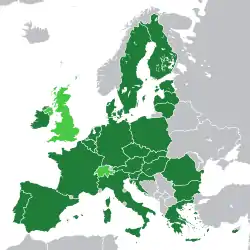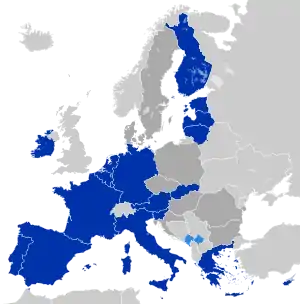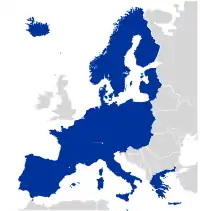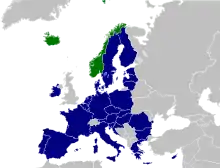Next Generation EU
In July 2020, the European Council agreed to a massive recovery fund of 750 billion € branded Next Generation EU (NGEU) in order to support member states hit by the COVID-19 pandemic. The NGEU fund goes over the years 2021–2023 and will be tied to the 2021–2027 budget of the EU (MFF). The comprehensive packages of NGEU and MFF will reach the size of 1824.3 billion €.[1]
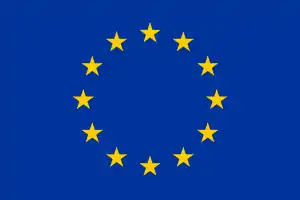 |
|---|
| This article is part of a series on the politics and government of the European Union |
|
|
The NGEU deal is unprecedented as for the first time in its history, the EU will issue European sovereign bonds to allocate grants and loans to the hardest-hit regions and sectors paying it off by generating own resources through direct taxation.[2]
Background
The initial response of Europe to the outbreak of COVID-19 in March 2020 was haphazard. Ignoring the virus pattern and putting financial concerns over health concerns, EU member states reacted unilaterally and refused to come to Italy's assistance to fight the massive virus outbreak in Lombardy eventually causing its spread across Europe.[3]
A summit of EU leaders on March 26, 2020,[4] where Germany and the Frugal Four refused a joint European recovery initiative, proved that the EU didn't live up to the pandemic threat.[5] Moreover Germany and France restricted external sales of critical medical supplies leading to shortages everywhere in the EU.[6]
When the virus killed tens of thousands, locked down millions and paralyzed economies across Europe, the situation got untenable and in May 2020 French President Emmanuel Macron and German Chancellor Angela Merkel refloated the initially dismissed recovery fund by proposing 500 billion € in joint European debt.[7]
The NGEU agreement
Recovery fund
The one-time Recovery fund NGEU, eventually set up on the European summit in July 2020, aims to repair the damage caused by the COVID-19 pandemic whilst supporting the Union’s green and digital long-term objectives.[8]
The funds borrowed will be used for 390 billion € in relief grants and 360 billion € in longer-duration loans[9] and will be repaid by 2058.[10] The package seems large, but will have a net fiscal effect across the Eurozone of just 1% annually.[11] 672.5 billion € will be allocated to the Covid19 Recovery and Resilience Facility (RRF) as the main instrument,[12] 77,55 billion € to minor programs such as ReactEU, Just Transition Fund, Rural Development etc.[13]
NGEU is limited in time: 70% of the grants provided by the RRF will be committed in the years 2021 and 2022. The remaining 30% shall be committed in 2023.[14] Allocation keys for the years 2021–2022 are unemployment rate and for the year 2023 cumulative loss in real GDP observed over the period 2020–2022.[15]
Climate action
An overall climate target of 30% will apply to the total amount of expenditure from the MFF and NGEU in compliance with the Paris climate accord[16] and in line with the objectives of the European Green Deal, the flagship initiative to address the climate emergency.[17]
EU revenue by own sources
NGEU is a push to a unified European fiscal policy. The EU will search for new revenue sources. As a first step, a new own resource based on non-recycled plastic waste will be introduced as of 2021. In the years to follow additional own resources are planned[18] for repayment of NGEU borrowing.[19]
National rebates
With the departure of the UK, there was also hope of phasing out the perk of national rebates in the EU.[20] But instead of this, the budget deal provides NGEU-skeptical Germany and the so-called Frugal Four Denmark, the Netherlands, Austria and Sweden with even larger rebates, in total 53.2 billion €[21] for the 2021–2027 budget period financed by all Member States according to their GNI.[22]
Rule of law
The NGEU mentions the importance of rule of law but remains deliberately vague.[23] Any strong conditionality concerning the governments of Poland and Hungary, accused of repeated breach of Article 7 of the Treaty on European Union, will be avoided.[24][25]
Governance
To receive support from the RRF, member states – technically assessed by the Commission – must prepare national Recovery and Resilience Plans (RRP), including targets, milestones and estimated costs.[26] Eventually the European Council will politically approve the proposals voted by qualified majority.[27]
The RRP must outline how each member state intends to use these investments to contribute to the green and digital priorities foreseen by the Commission. In order to do so, two targets have been set: 37% of the spending must be devoted to green and 21% to digital investments.[28]
The deadline for submission of the Recovery and Resilience plans is 30 April 2021. Member States are encouraged to submit a preliminary draft plan from 15 October 2020.
Notes
- Special European Council, 17-21 July 2020 - Main results Retrieved 15 November 2020.
- European Council 2020, chpt.A29, 146.
- The first waves of the COVID-19 pandemic Retrieved 15 November 2020.
- Video conference of the members of the European Council, 26 March 2020 Retrieved 15 November 2020.
- EU leaders clash over economic response to coronavirus crisis Retrieved 15 November 2020.
- EU limits on medical gear exportsRetrieved 15 November 2020.
- The coronavirus recovery plan Retrieved 15 November 2020.
- European Council 2020, chpt. A2.
- European Council 2020, chpt. A6.
- European Council 2020, chpt. A7.
- While EU leaders squabble, the Elephant in the Room remains unnoticed Retrieved 15 November 2020.
- COVID-19: Council agrees its position on the Recovery and Resilience Facility Retrieved 15 November 2020.
- European Council 2020, chpt. A14.
- European Council 2020, chpt. A15.
- European Council 2020, chpt. A16.
- European Council 2020, chpt. A21, 18.
- "Press corner". European Commission - European Commission. Retrieved 2020-12-14.
- European Council 2020, chpt. A29, 146, 147.
- European Council 2020, chpt. 150.
- The history of national rebates in the EU Retrieved 15 November 2020.
- European Council 2020, chpt. 152.
- European Council 2020, chpt. A30.
- European Council 2020, chpt. A24, 22, 23.
- Europe Bails Out Its Populists Retrieved 15 November 2020.
- What EU leaders really decided on rule of law Retrieved 15 November 2020.
- Council agrees position on the Recovery and Resilience Facility Retrieved 15 November 2020.
- Follow-up session of the European Council in autumn 2020 Retrieved 15 November 2020.
- "See No Evil. How a lack of transparency could dash EU hopes for a green pandemic recovery" (PDF). CEE Bankwatch Network. November 2020.
|first=missing|last=(help)
References
- European Council (2020). Special meeting of the European Council, 17-21 July 2020 – Conclusions (PDF). Retrieved 15 November 2020.CS1 maint: ref=harv (link)

